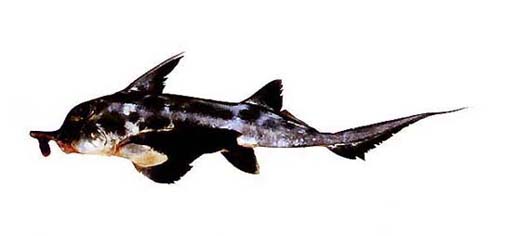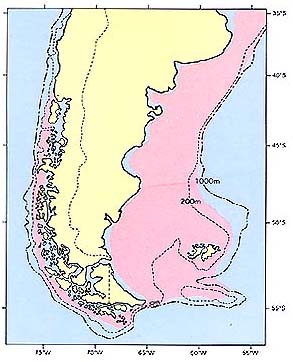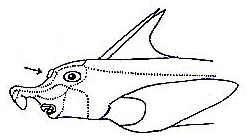ゾウギンザメ科
- HOME
- デジタル図鑑
- パタゴニア海域の重要水族
- 軟骨魚綱 ギンザメ目 ゾウギンザメ科
ゾウギンザメ科(Callorhynchidae)

1 ゾウギンザメ(Zou-ginzame)
Callorhynchus callorhynchus(Linnaeus, 1758)
Hijo del pais, Músico, Pez gallo, Pez elefante, Pez músico (Arg.); Ñato, Peje gallo (Peru); Achagual, Chalgua, Peje gallo (Ch.); Gallo, Pexe gallo (Urg.)
ギンブカ(業界名)
特 徴:
頭長は体長(鰓孔から尾鰭上葉起部まで)の42.9〜47.5%,吻長は27.4〜29.9%,眼径は5.6〜6.8%,両眼間隔は11.8〜13.1%,口幅は5.1〜8.8%,鰓孔長は8.0〜13.9%,交接器長は5.6〜6.8%,吻端から口までの距離は17.3〜18.6%,胸鰭前長は43.9〜46.3%,胸鰭長は46.8〜54.2%,第1背鰭高は30.8〜35.9%,第2背鰭高は20.5〜25.9%,腹鰭長は21.5〜24.1%,体高は28.8〜29.6%,体幅は16.1〜19.8%,第1背鰭基底長は38.3〜42.6%,第2背鰭基底長は20.5〜25.9%,鰓孔から第1背鰭起部までの距離は22.7〜23.2%,鰓孔から第2背鰭起部までの距離は51.2〜57.7%,鰓孔から胸鰭起部までの距離は3.7〜5.3%,鰓孔から腹鰭までの距離は46.6〜52.8%,鰓孔から尾鰭下葉起部までの距離は92.7〜95.6%。体は側扁し,体高は第1背鰭起部付近で最高。尾鰭上葉は延長してむち状を呈し,下葉は短い。頭部は丸味をおびる。吻端に鍬状の肉質突起がある。前頭部に小さな把握器がある。口は小さく,頭部下面に開く。唇褶や肉質突起が口の周囲によく発達する。側線は背部をやや波打ちながら尾部まで走り,前方で発達した頭部感覚管系と連続する。眼は小さく,眼隔域は広い。第1背鰭は胸鰭起部のやや前方に始まり,前縁に強大な前後に鋸歯縁を有する棘がある。第2背鰭は第1背鰭より低いが基底はより長い。胸鰭は著しく大きく,先端は腹鰭起部を越える。腹鰭は第2背鰭起部よりやや前方に位置する。尾鰭と分離した臀鰭が,尾鰭下葉の直前にある。全長は1mに達する。
分 布:
チリ,アルゼンチン パタゴニアの陸棚上に分布する。ペルー,ウルガイ,南部ブラジルからも知られている。
備 考:
ニュージーランド,オーストラリアに分布するC. milliと南アフリカに分布するC. capensisに極めてよく似ているので,今後の比較研究が待たれる。いずれの地方でもフライとして賞味される。
(中村 泉)
Material examined:
3 specimens♂♂ from Chile (378.0-436.0 mm TL), FAKU 109189・1-3.
Description:
HL 42.9-47.5% of BL (Gill-opening to origin of upper caudal fin); SN 27.4-29.9; ED 5.8-6.8; IO 11.8-13.1; Mouth width 5.1-8.8: Gill-opening L 8.0-13.9; Clasper L 5.6-6.8; Snout to mouth 17.3-18.6; PreP1 43.9-46.3; P1L 46.8-54.2; D1H 30.8-35.9; D2H 20.5-25.9; P2L 21.5-24.1; BD 28.8-29.6; BW 16.1-19.8; D1 base L 38.3-42.6; D2 base L 20.5-25.9; Gill-opening to D1 origin 22.7-23.2; Gill-opening to D2 origin 51.2-57.7; Gill-opening to P1 origin 3.7-5.3; Gill-opening to P2 origin 46.6-52.8; Gill-opening to C (lower lobe) origin 92.7-95.6.
Body compressed and fairly deep, deepest at origin of first dorsal fin. Caudal fin elongate and tapered. Head round. Mouth small and inferior. Snout elongate and strongly downturned; hence vernacular name “elefant fish" or “Pez elefante". Labial furrows and dermal fringes well developed around mouth. Frontal clasper present in male. A lateral line running close to dorsal profile, connecting anteriorly with well developed cephalic sensory canal system. First dorsal fin, originating slightly before pectoral fin origin with a large serrated cartilaginous spine. Pectoral fin very large, its tip beyond pelvic fin origin. Pelvic fin origin slightly anterior to 2nd dorsal fin origin, both fins triangular in shape, 2nd dorsal fin larger than pelvic fin. Anal fin situated closely to caudal fin with a deep notch in between.
Distribution:
Both Chilean and Argentine Patagonia, chiefly on continental shelf.
Remarks:
Closely related to Callorhynchus millii from New Zealand and Australia, and C. capensis from South Africa. Three species are presently recognized, though Nelson (1976) recognized 4 species in Callorhynchus. They are commonly used for “fish and chips".
(Izumi NAKAMURA)

Distribution of Callorhynchus callorhynchus in Patagonia.

Cephalic sensory canal system.
Frontal clasper arrowed.
- 1